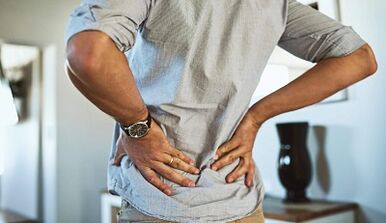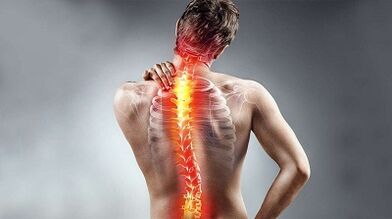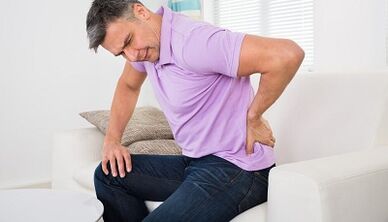
Back pain can occur at any age, but more often occurs between 35 and 55 years.Spine pain is associated with how the bones, muscles, intervertebral discs, ligaments, tendons and nerves work.
Spine pain can be caused by problems with vertebrae, discs, ligaments around the spine and discs, spinal cord and nerves, posterior muscles, internal organs in abdominal and pelvic areas.Also, aortic diseases, chest tumors and inflammation of the spine on the upper back can be the cause of the upper back pain.
Risk factors
The presence of risk factors increases the likelihood of a state growth.For example, obesity significantly increases the risk of diabetes of the second type.
The following factors are associated with increasing the risk of back pain.
- office work;
- work associated with constant stress.
- Pregnancy - Pregnant women often suffer from spine pain.
- Lifestyle.
- age;
- depression;
- obesity/overweight.
- smoking;
- heavy physical exercises;
- heavy physical work.
Signs and symptoms of back pain
The symptom is what the patient feels, while the doctor may notice the sign.For example, pain is a symptom, while a rash is a sign.
The main symptom of spine pain is pain in any part of the back.Sometimes the pain extends to the buttocks and legs or shoulder and hands.
You should contact your doctor immediately if the pain in the spine is accompanied by some of the following signs:
- weight loss;
- High temperature (fever);
- Back pain is not relieved after rest.
- painful pain
- the pain that is reduced below the knee.
- The presence of fresh spinal cord injury.
- urine incontinence (even a small part).
- Urinary difficulties - urine is difficult.
- Famous incontinence - Loss of abstraction control control.
- numbness in the field of genitals.
- numbness in the anus.
- Numbness in the buttocks.

Apply for the advice of a specialist if you are one of these groups:
- People under 22 years and over 55 years.
- Patients who received steroids for several months.
- Patients with cancer.
- Patients who once had cancer.
- Patients with low immunity.
The causes of back pain
The human spine is a complex structure consisting of muscle, ligaments, tendons, discs and bones.The intervertebral discs are located between each pair of vertebrae and act as shock absorbers of friction.Problems with any of these ingredients can lead to spine pain.In some cases, the causes of pain cannot be established.
Extends
The most common causes of spine pain are:
- stretched muscles.
- Stretched links.
- lifting a heavy object to the wrong attitude.
- lifting a very heavy object.
- the result of a sharp and embarrassing movement.
- Muscle spasm.
Structural problems
The following structural problems can lead to spine pain:
- Protency of the intervertebral disc.The rupture of the outer case of the disk leads to the swelling of its inner content outward.This can lead to nerve bites and, as a result, pain.
- A hernia of the intervertebral disc- Stabits of the internal content of the large discs.
- sciatica- Acute and painry pain, which radiates on the buttock and back area of the foot caused by the protrusion or intervertebral disc shells, compressing the nerve.
- arthritis- Patients with osteoarthritis usually have problems with thigh joints, lumbar spine, knees and hands.In some cases, stenosis of the spine may occur, since the space around the spinal cord is limited.
- Abnormal spine turn- If the spine is bent unusual, the patient is more likely to suffer from spine pain.An example of an abnormal bending is scoliosis, in which the spine bends to the side.
- osteoporosis- Bones, including vertebrae, become fragile and porous, leading to an increase in their fragility.

Below are some other causes of spine pain:
- Tail syndrome- The ponytail is a bunch of nerve roots in which the spinal cord branches.People with horse tail syndrome feel boring pain in lumbar spine and buttocks.There may also be a loss of the sensitivity of the buttocks, the genitals, the thigh.Sometimes people with horse tail syndrome suffer from urine and/or feces.
- spine cancer- The tumor found in the spine can compress the nerve, which leads to pain.
- Spine infection- If the patient has a high body temperature and also has a painful hot back area, then this may indicate the infection of the spine.
- Other infections- Inflammation of the pelvic organs in women, as well as bladder and kidney infections can also cause back pain.
- sleep disorders- People with sleep disorders often experience spine pain in relation to the general population.
- herpes- Infection that can affect the nerves.
- Inappropriate mattress- If the layer does not support certain parts of the body and does not ensure the uniform position of the back, there is a risk of spinal pain.
Also, the cause of spine pain may be certain body movements or positions, such as prolonged driving, coughing and so on.
What to do when it hurts back
If you experience spine pain for several days, then the tips below will help you reduce pain and hassle and speed up recovery:

- Stay on.
- If necessary, use over the painkillers.
- Use warm and cold compresses.There will be a bottle of warm water and a bag of frozen vegetables.
Although it is difficult to stay optimistic when suffering from pain, try not to lose the heart.This will speed up the recovery process.
With prolonged spine pain, which does not spend within six weeks, you should consult a doctor.The doctor will write a medical history, conduct an examination and, if necessary, will direct it to additional studies.The doctor may prescribe x -rays in the event of a suspicion of a problem with a bone system or osteoarthritis, CT (computed tomography) or magnetic resonance imaging (magnetic resonance imaging) in the event of suspicion of intervertebral hernia or other problems associated with soft tissues.In such a situation, MRI is the best choice.The doctor may also advise you to deliver certain laboratory tests or measure nerve electrical activity (EMG).
After diagnosis, the doctor provides treatment.For most cases, there is a sufficiently conservative treatment, which may include:
- special exercises;
- Reflexology?
- extension of the spine.
- massage.
In severe cases, the business issue may be raised.The surgeon will help you choose the right method and also advise for possible complications.Shortly after operation, undergraduate therapy of the spine is recommended.Remember that the functions of the spine are quite dangerous, as the operation area is in immediate proximity to the nerves.















































